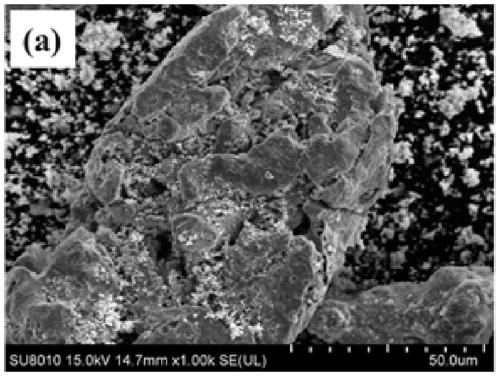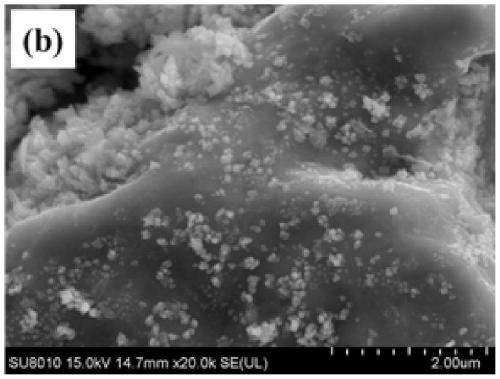A method for removing antibiotic resistance genes in livestock and poultry wastewater
A technology for antibiotic resistance and waste water, which is applied in animal husbandry waste water treatment, chemical instruments and methods, animal processing waste water treatment, etc. It can solve the problems of complex operation, secondary pollution, and high removal cost, and achieve cheap and easy raw materials, reduce Effects of losing and gaining weight
- Summary
- Abstract
- Description
- Claims
- Application Information
AI Technical Summary
Problems solved by technology
Method used
Image
Examples
Embodiment 1
[0024] A method for removing antibiotic resistance genes in livestock and poultry wastewater, comprising the following steps:
[0025] (1) Add copper sulfate pentahydrate to hot water at 35°C, stir until copper sulfate pentahydrate dissolves, then add iron powder with a particle size of 100 μm to the solution, continue stirring until the solution turns reddish brown, let stand, pour The supernatant was discharged, and the remaining solid matter was rinsed with tap water to obtain nano-copper cluster particles; wherein, the addition of copper sulfate pentahydrate in every liter of hot water was 6g, and the addition of iron powder was 8g;
[0026] (2) Take the livestock and poultry waste water after anaerobic digestion treatment, heat it to 23°C, keep it for 4min, then add 8g of the nano-copper cluster particles obtained in step (1) to it, stir at a rotating speed of 250r / min 20min is enough.
Embodiment 2
[0028] A method for removing antibiotic resistance genes in livestock and poultry wastewater, comprising the following steps:
[0029] (1) Add copper sulfate pentahydrate to hot water at 45°C, stir until copper sulfate pentahydrate dissolves, then add iron powder with a particle size of 140 μm to the solution, continue to stir until the solution turns reddish brown, let stand, pour The supernatant was discharged, and the remaining solid matter was rinsed with tap water to obtain nano-copper cluster particles; wherein, the addition of copper sulfate pentahydrate in every liter of hot water was 9g, and the addition of iron powder was 12g;
[0030] (2) Take the livestock and poultry wastewater after anaerobic digestion treatment, heat it to 27° C. and keep it for 10 min, then add 12 g of the nano-copper cluster particles obtained in step (1) to it, and stir at a rotating speed of 250 r / min. 50min is enough.
Embodiment 3
[0032] A method for removing antibiotic resistance genes in livestock and poultry wastewater, comprising the following steps:
[0033] (1) Add copper sulfate pentahydrate to hot water at 40°C, stir until copper sulfate pentahydrate dissolves, then add iron powder with a particle size of 120 μm to the solution, continue to stir until the solution turns reddish brown, let stand, pour The supernatant was removed, and the remaining solid matter was rinsed with tap water to obtain nano-copper cluster particles; wherein, the addition of copper sulfate pentahydrate in each liter of hot water was 7.8 g, and the addition of iron powder was 10 g;
[0034] (2) Take the livestock and poultry wastewater treated by the autotrophic denitrification reactor, heat it to 27° C. and keep it for 7 min, then add 10 g of the nano-copper cluster particles obtained in step (1) to it, and heat it at 250 r / min. Stir at the speed of 30min.
PUM
| Property | Measurement | Unit |
|---|---|---|
| particle diameter | aaaaa | aaaaa |
| particle diameter | aaaaa | aaaaa |
| particle diameter | aaaaa | aaaaa |
Abstract
Description
Claims
Application Information
 Login to View More
Login to View More - R&D
- Intellectual Property
- Life Sciences
- Materials
- Tech Scout
- Unparalleled Data Quality
- Higher Quality Content
- 60% Fewer Hallucinations
Browse by: Latest US Patents, China's latest patents, Technical Efficacy Thesaurus, Application Domain, Technology Topic, Popular Technical Reports.
© 2025 PatSnap. All rights reserved.Legal|Privacy policy|Modern Slavery Act Transparency Statement|Sitemap|About US| Contact US: help@patsnap.com


